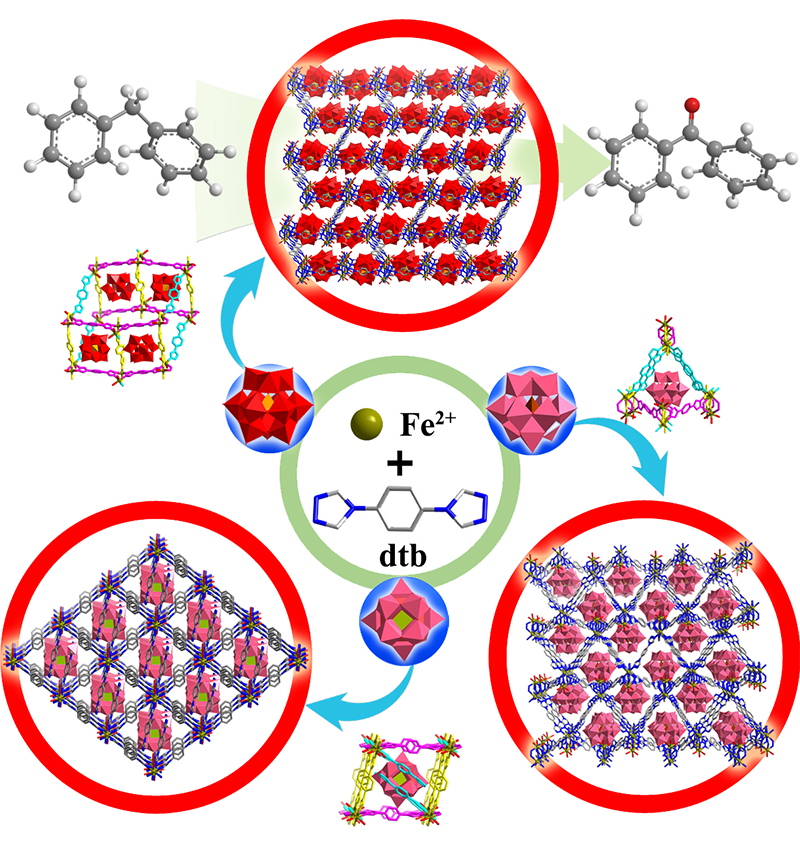Polyoxometalate-encapsulated metal-organic frameworks with diverse cages for the C–H bond oxidation of alkylbenzenes
Yue Wang, Ze-Xuan Liu, Xing-Pu Zhao, Yuan-Yuan Ma*, Si-Meng Zhang, Wen-Jing Cui, Jing Du*, Zhan-Gang Han*
Chin. J. Struct. Chem., 2023, 42: 100011. DOI: 10.1016/j.cjsc.2023.100011
February 15, 2023Polyoxometalate, Metal-organic framework, Heterogeneous catalysis, C–H bond oxidation
ABSTRACT
Exploring new heterogeneous catalysts to achieve efficient C–H bond oxidation is momentous in industrial chemical production. Herein, three Fe-incorporated polyoxometalate-encapsulated metal-organic frameworks (POM@MOFs), [Fe(H2O)3(dtb)][Fe(dtb)2][HBW12O40]·12H2O (1), [Fe(H2O)2(dtb)]2[Fe(dtb)2(Hdtb)][SiWVI9WV3O40]·16H2O (2), [Fe(H2O)2]4(dtb)5[PMoVI11MoVO40]2·18H2O (3), (dtb = 1,4-di[4H-1,2,4-triazol-4-yl]-benzene), were hydrothermally synthesized for catalytic C–H bond oxidation. They exhibited three-dimensional (3-D) POM-based metal-organic host-guest frameworks with diverse cages. In compound 1, cationic metal-organic frameworks constructed by binuclear [Fe2(dtb)6(H2O)2]4+ clusters and dtb ligands present a pcu alpha-Po primitive cubic topological net and abundant twisted quadrangular prism-shaped cages, in which the monoprotonated [HBW12O40]4– polyoxoanions are encapsulated. In compound 2, two-dimensional (2-D) cationic metal-organic layers constructed by trinuclear [Fe3(dtb)6(H2O)4]6+ clusters and dtb ligands display a sql/Shubnikov tetragonal plane net topology, in which the rhomboid-shaped metal-organic windows in adjacent parallel-arranged 2-D layers are enclosed to form an open parallelepiped cage. The [SiWVI9WV3O40]7– polyoxoanions locate in the parallelepiped cages between 2-D bilayers. In compound 3, the 3-D cationic metal-organic frameworks constructed by binuclear [Fe2(dtb)3(H2O)4]4+ clusters and dtb ligands possess a bnn hexagonal BN topology, in which the hexagonal prismatic metal-organic cages accommodate four [PMoVI11MoVO40]4– polyoxoanions. Employing diphenylmethane (DPM) oxidation as C–H bond oxidation model reaction, compounds 1–3 displayed distinct catalytic activities owing to the synergistic effect of polynuclear Fe nodes and polyoxoanions. Among them, [PMoVI11MoVO40]4–-contained compound 3 exhibited higher catalytic activity than polyoxotungstate-based compounds 1–2 with 99% DPM conversion and 99% benzophenone (BP) selectivity within 6 h as well as good recyclability and structural stability.








